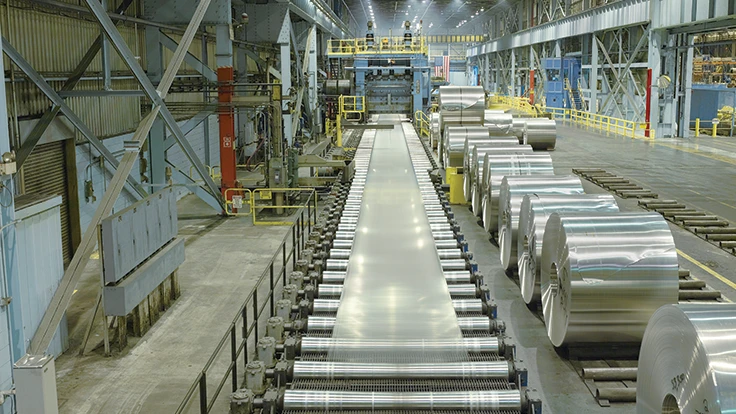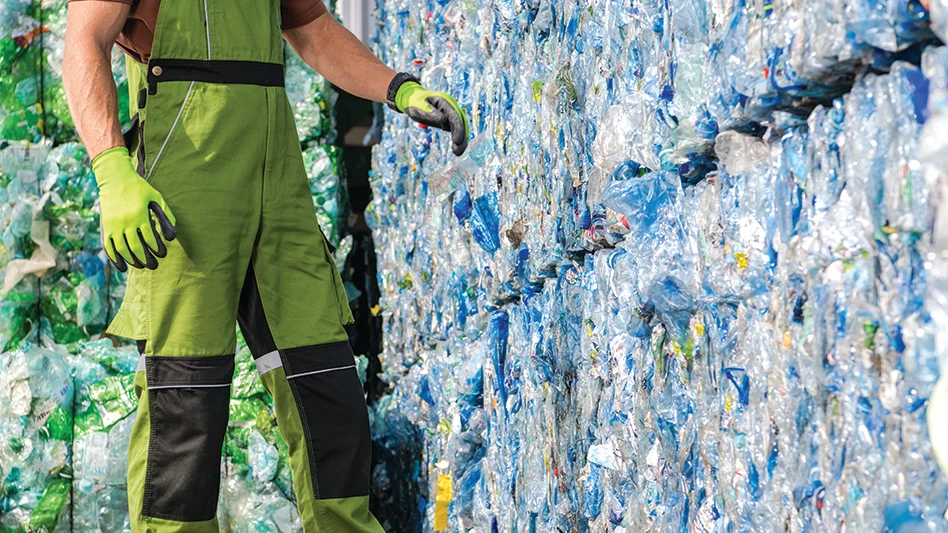
The amount of aluminum used in automobiles has increased threefold since the mid-1980s, and its use in vehicles will continue to grow, according to speakers at the Institute of Scrap Recycling Industries (ISRI) Convention & Exposition, held April 2-7 at the Mandalay Bay Convention Center in Las Vegas.
Panelists in the session “The Increased Use of Aluminum in the Automotive Industry and its Impact on Recycling” outlined the lightweighting benefits and closed loop capabilities offered by using aluminum in vehicles. Speakers also discussed the significance of thinking ahead regarding capacity, as making the switch to aluminum-bodied vehicles is no quick shift.
Original equipment manufacturers (OEMs) can make efforts, including working closely with suppliers, to ensure capacity is there.
Speaker Mark DiFalco, manager at KPMG LLP, a Netherlands-based audit, tax and advisory firm, said, “Going forward, as OEMs look to increase aluminum or go to full body aluminum, they have to work closely with suppliers to ensure capacity is there. [Capacity] takes a lot of planning.”
Ford Motor Co. learned this when the company first made the switch to aluminum bodies for its F-150 pickup truck, he said. “When Ford went to do this, there wasn’t enough capacity,” DiFalco noted.
To convert vehicles to aluminum, Ford is estimated to spend $1 billion retooling its facilities in Dearborn, Michigan, and Kansas City, Missouri, said Vince Pavlak, a partner advisory at KPMG, who also spoke during the Wednesday session. Later this year, Ford is coming out with the all-aluminum Super Duty truck.
Pavlak said of Ford’s capacity changes, “It’s not an easy task and takes a lot of coordination. If they screw up it goes down their production line … It’s very risky business.”
America’s best-selling truck serves as an example of where the industry is headed, DiFalco said. In addition, the Ford F-150 is a leading indicator, he said.
He pointed to the car manufacturer’s closed-loop system it has created, which “has saved them a lot of money.”
Supply for the F-150 truck involves a highly innovative closed-looped recycling system, ensuring manufacturing scrap is recycled in a closed loop between Ford and Atlanta-based aluminum rolling and recycling company Novelis. Supplying lightweight automotive aluminum for the Ford F-150, 700 pounds is eliminated from the vehicle, making it highly fuel efficient.
DiFalco listed additional advantages the F-150 has acquired since its aluminum-body switch, including:
Panelists in the session “The Increased Use of Aluminum in the Automotive Industry and its Impact on Recycling” outlined the lightweighting benefits and closed loop capabilities offered by using aluminum in vehicles. Speakers also discussed the significance of thinking ahead regarding capacity, as making the switch to aluminum-bodied vehicles is no quick shift.
Original equipment manufacturers (OEMs) can make efforts, including working closely with suppliers, to ensure capacity is there.
Speaker Mark DiFalco, manager at KPMG LLP, a Netherlands-based audit, tax and advisory firm, said, “Going forward, as OEMs look to increase aluminum or go to full body aluminum, they have to work closely with suppliers to ensure capacity is there. [Capacity] takes a lot of planning.”
Ford Motor Co. learned this when the company first made the switch to aluminum bodies for its F-150 pickup truck, he said. “When Ford went to do this, there wasn’t enough capacity,” DiFalco noted.
To convert vehicles to aluminum, Ford is estimated to spend $1 billion retooling its facilities in Dearborn, Michigan, and Kansas City, Missouri, said Vince Pavlak, a partner advisory at KPMG, who also spoke during the Wednesday session. Later this year, Ford is coming out with the all-aluminum Super Duty truck.
Pavlak said of Ford’s capacity changes, “It’s not an easy task and takes a lot of coordination. If they screw up it goes down their production line … It’s very risky business.”
America’s best-selling truck serves as an example of where the industry is headed, DiFalco said. In addition, the Ford F-150 is a leading indicator, he said.
He pointed to the car manufacturer’s closed-loop system it has created, which “has saved them a lot of money.”
Supply for the F-150 truck involves a highly innovative closed-looped recycling system, ensuring manufacturing scrap is recycled in a closed loop between Ford and Atlanta-based aluminum rolling and recycling company Novelis. Supplying lightweight automotive aluminum for the Ford F-150, 700 pounds is eliminated from the vehicle, making it highly fuel efficient.
DiFalco listed additional advantages the F-150 has acquired since its aluminum-body switch, including:
- 15 percent improvement of power-to-weight ratio as a result of lightweighting;
- 700 pounds overall weight reduction, with 450 pounds estimated from body and frame;
- towing capacity remains same or better;
- maximum payload capacity increased; and
- half of body stampings use military grade 6,000 series aluminum alloy, estimated more than 1,000 pounds of total aluminum use.
For vehicles in general, DiFalco said aluminum usage is mostly increasing in body and closure parts, such as hoods, fenders and doors.
He cited the threefold increase of total aluminum usage in vehicles, from 139 pounds in 1985 to 394 pounds in 2015. By 2025, the average vehicle will have 547 pounds of aluminum, a 39 percent increase from today, DiFalco said.
Along with aluminum in the automotive industry, India is well-positioned to grow quickly, said speaker Mohan Agarwal, managing director of Century Metal Recycling Private Ltd. (CMR), based in India.
Agarwal said one area that needs improvement is better sorting technology for scrap users.
Auto OEMs, on the other hand, have adopted innovative vehicle designs, said DiFalco.
Despite efforts to lightweight and add more aluminum, some consumers do not care much about vehicle specifications, how much horsepower the engine has or what the style is, Pavlak said. Drivers’ biggest concern is whether they are able to sync their cellphones with their cars, he said.
Additionally, Pavlak said, the automotive industry has a number of challenges: connectivity and digitization, launch/capacity, safety, quality and recall, autonomous vehicles and car-sharing, talent issues, electric vehicles, economic slowdown, margin erosion, rapid changes in electronics, health care and labor, regulations and lightweighting.
Lightweighting vehicles in an effort to improve fuel economy standards will continue to be a trend. Pavlak shared that a family that purchases a new vehicle in 2025 will save $8,200 in fuel costs when compared to a similar vehicle in 2010.
Nevertheless, Pavlak said, “The forecast for aluminum is very positive.”
The ISRI 2016 Convention & Exposition was April 2-7 at the Mandalay Bay Convention Center in Las Vegas.
He cited the threefold increase of total aluminum usage in vehicles, from 139 pounds in 1985 to 394 pounds in 2015. By 2025, the average vehicle will have 547 pounds of aluminum, a 39 percent increase from today, DiFalco said.
Along with aluminum in the automotive industry, India is well-positioned to grow quickly, said speaker Mohan Agarwal, managing director of Century Metal Recycling Private Ltd. (CMR), based in India.
Agarwal said one area that needs improvement is better sorting technology for scrap users.
Auto OEMs, on the other hand, have adopted innovative vehicle designs, said DiFalco.
Despite efforts to lightweight and add more aluminum, some consumers do not care much about vehicle specifications, how much horsepower the engine has or what the style is, Pavlak said. Drivers’ biggest concern is whether they are able to sync their cellphones with their cars, he said.
Additionally, Pavlak said, the automotive industry has a number of challenges: connectivity and digitization, launch/capacity, safety, quality and recall, autonomous vehicles and car-sharing, talent issues, electric vehicles, economic slowdown, margin erosion, rapid changes in electronics, health care and labor, regulations and lightweighting.
Lightweighting vehicles in an effort to improve fuel economy standards will continue to be a trend. Pavlak shared that a family that purchases a new vehicle in 2025 will save $8,200 in fuel costs when compared to a similar vehicle in 2010.
Nevertheless, Pavlak said, “The forecast for aluminum is very positive.”
The ISRI 2016 Convention & Exposition was April 2-7 at the Mandalay Bay Convention Center in Las Vegas.
Latest from Recycling Today
- EPA releases ‘National Strategy to Prevent Plastic Pollution’
- South Carolina launches recycling app
- Resource Recycling Systems transitions to employee ownership model, refreshes branding
- APR upgrades PCR certification program
- WM completes $40M automation project at Philadelphia MRF
- Speira commissions new furnace in Germany
- ABB report portrays paper sector circularity, emissions reduction
- RMDAS and Davis Index numbers portray stalled ferrous market





